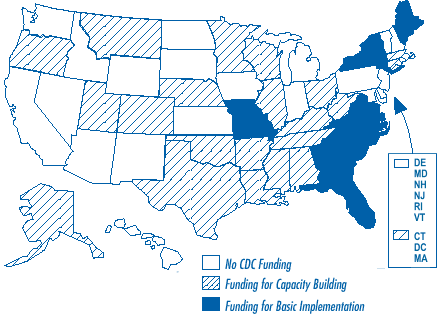 |
|
 |
 |
 |
A
Public Health Action Plan to Prevent Heart Disease and Stroke
Return to Table of Contents
The
Challenge
Despite the major progress in reducing
death rates from heart disease and stroke, their total impact has increased
in the past 50 years according to many health status indicators.1,6
In the United States, growing numbers of people are dying from these
conditions or surviving with disability, dependency, and high risk for
recurrence. During the 1990s, although the overall death rate for these
conditions declined 17.0%, the actual number of deaths increased 2.5%. This
reflects, in part, growth in the population over age 65, which has the
highest rates and therefore contributes most to the mounting numbers of
deaths each year.7
|
In
2002, CDC funded cardiovascular disease prevention programs in 29
states and the District of Columbia. The Heart Disease and Stroke
Prevention Program is designed to reduce disparities in treatment,
risk factors, and disease; delay the onset of disease; postpone
death; and reduce disabling conditions. The goal is a national
program with sufficient funding for every state.
CDC Funding for State Programs
Fiscal Year 2002
 |
[A text description of this map
is also available.]
As a result, heart disease remained the
nation's leading cause of death in 2000 for women and men and for nearly
every racial and ethnic group. Stroke is the third leading cause of death,
and both conditions are major causes of disability for people 65 and older,
as well as for many younger adults. Thus, the importance of these conditions
is not restricted to the older population, though the number of victims at
older ages are especially great. Risk factors such as diabetes have
increased sharply, even for younger people.8 Growing health
disparities place certain populations, especially racial or ethnic
minorities and people of low income or education, at excess risk relative to
groups with the most favorable rates of heart disease and stroke.9–12
Aging of the baby boom generation portends a sharp rise by 2020 in the
number of people who die from heart disease and stroke or survive with
dependency.3,4
Clearly, heart disease and stroke
contribute substantially to the nation's health care crisis, as addressed by
Secretary of Health and Human Services Tommy G. Thompson in his initiative,
Steps to a HealthierUS. This initiative places an important new
emphasis on prevention of chronic diseases and conditions. The epidemic of
heart disease and stroke can be expected to continue, with an increasing
burden and widening disparities, unless unprecedented public health efforts
are mounted to arrest and reverse it. This challenge will test the ability
of public health institutions at all levels to fulfill their obligation to
protect society against this rising epidemic. Three factors affect the
current challenge.
- Support for public health programs to
prevent heart disease and stroke is low. State public health agencies
expend less than 3% of their budgets on chronic disease programs,
including heart disease and stroke prevention.7
- The costs of failure are very high.
The economic costs of heart disease and stroke rise each year. These
costs include the numbers of people requiring treatment for risk factors
or early signs of disease; emergency treatment for first or recurrent
episodes of heart attack, heart failure, or stroke; and efforts to reduce
disability and prevent recurrent episodes. In 2003, health care costs
alone are projected to be $209.3 billion. Although personal and societal
costs are incalculable, they include another $142.5 billion in lost
productivity.1 These costs will escalate further if this
epidemic is not halted and reversed. As noted by Secretary Thompson,
chronic diseases and conditions, including heart disease, consume more
than 75% of our nation's health care dollars, yet they are largely
preventable.
- An unprecedented opportunity to
prevent heart disease and stroke exists today in the United States. We
know what causes these conditions and how to prevent them, largely because
of the decades of research supported by NIH, the American Heart
Association, and others.6 Healthy People 2010 has
outlined clear goals, and the Healthy People 2010 Heart and Stroke
Partnership* was established to help in achieving them.5 Also,
health professionals have become more aware of the need for immediate
action as they increasingly recognize the continuing cardiovascular
epidemic, recent unfavorable trends, and forecasts of a mounting disease
burden.8
* Current partners include the American
Heart Association/American Stroke Association, CDC, Centers for Medicare &
Medicaid Services, Indian Health Service, NIH, and Office of Public Health
and Science, U.S. Department of Health and Human Services.
Next Section: The Public
Health Response
Return to Table of Contents
Date last reviewed:
05/12/2006
Content source: Division for Heart Disease and Stroke
Prevention,
National Center for Chronic Disease Prevention and
Health Promotion |
|